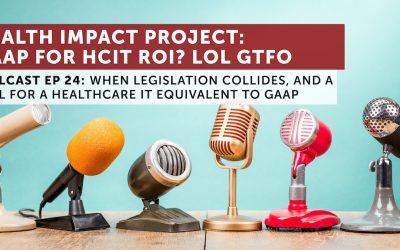Hipaa’s Use as Code of Silence Often Misinterprets the Law
Paula Span for The New York Times
“Confusion about HIPAA privacy and security is one thing. Feigned confusion is another. This article highlights ways in which either kind of confusion could lead to less than optimal outcomes. HIPAA is often cited as a reason for not sharing patient data in contexts where HIPAA does not apply. Erring on the side of caution with respect to provider liability seems to trump erring on the side of caution with respect to better patient care in too many instances.” – Brian M.
CVS Health Taps IBM’s Watson To Predict Patient Health Decline Before It Happens
Sarah Buhr for TechCrunch
“There is very little by way of information in this article about CVS Health’s partnership with Watson. The announcement itself raises some interesting questions though, around how deeply CVS is aiming to get involved in the care process with its pharmacists, as well as how much insight they can derive without access to other clinical data from the EHR. However, with unique datapoints potentially in the mix (such as shopping patterns), this may be worth following as it develops.” – Naveen
Working Under a Clinic-Level Quality Incentive: Primary Care Clinicians’ Perceptions
Jessica Greene, et al in Annals of Family Medicine
“A recent study published in the Annals of Family Medicine that looked at how PCPs responded to individualized versus clinic-based pay-for-performace (P4P) systems. Most PCPs believed their should be a mix of individual and team-based incentives but also highlighted several of the difficulties in designing mixed P4P payments to providers including lack of control of what their colleagues did, fears low-performers would ‘ride the coattails’ of high performers, and confrontations it might cause. Perceived strengths of the clinic-based quality P4P payments were greater efforts on quality improvement for the team and less patient dumping. This is one of several issues that is challenging with P4P along with the reality that provider organizations have their own internal payment distribution methodologies for physicians different than what the payers’ P4P payment schemes.” – Matt
What I Learned at the Weed Dispensary
David Casarett for The New York Times
“What can traditional healthcare practitioners learn from the burgeoning medical marijuana industry? A few things, according to the physician who wrote this Op-Ed. Due to the culture and “workflow” of the medical marijuana facilities the author spent time in, patients gain an ability to talk with each other about their symptoms, spend extended time with non-medical staff to get their questions answered, and take matters into their own hands when it comes to how much, how often, and what sorts of dosage they want to try taking.” – Naveen
Is ObamaCare creating corporate behemoths in the health care market?
Jeff Spross for The Week
“Not unlike the healthcare provider consolidation the industry has seen in the last few years, the Aetna-Humana and Anthem-Cigna mergers are, by and large, a byproduct of the Affordable Care Act and the recession that preceded it. Mergers provide better economy of scale when it comes to adding customers, and size matters when it comes to negotiating prices. Merger mania has since been blamed for rising premium prices, but the real reasons are more complicated.” – Brian E.
With millions more expected to develop Alzheimer’s, more research funding demanded
Melissa Healy for The LA Times
“Alzheimer’s is poised to seriously strain the Medicare (and Medicaid) budgets especially starting in the later 2020s as more and more Boomers enter into their 70s and 80s since the risk of Alzheimer’s notably begins to increase after age 70. While the NIH budget is increasing funding on Alzheimer’s, it does not seem proportionate to the amount of future costs that might be alleviated if better treatments and diagnoses were available sooner. Article also doesn’t highlight how largely dysfunctional the long-term care insurance market is in the U.S. or the current issues in diagnosing Alzheimer’s in patients including the lack of a ‘gold standard’ clinical diagnostic criterion.” – Matt
Technology, While Not a Fountain of Youth, Can Make Aging Safer
Constance Gustke for The New York Times
“This article points out how the market for aging in place is beginning to gain traction among consumers and their family members. Cheaper alternatives to top shelf technology (i.e. Apple Watch) are likely to flood the market as people search for affordable options to outfit their parents homes (and bodies) with sensors to monitor health, falls, and even medication adherence. Increasingly, it seems like the monitoring portion of this use case will be separate from “the system” – and run instead by home health agencies, eldercare communities, and the like.” – Naveen
As Medicare and Medicaid Turn 50, Use of Private Health Plans Surges
Robert Pear for The New York Times
“As Medicare and Medicaid turn 50, the New York Times looks at the growing role that private insurers play in the public programs. The commercial market was never supposed to play a part in the programs — in fact, they were created specifically because the commercial market ignored the needs of elderly and low-income Americans — but private payers now cover more than 30 percent of Medicare beneficiaries and more than half of those on Medicaid. While this has allowed the programs to expand coverage, especially in light of the Affordable Care Act, some critics say the private plans leave a little to be desired.” – Brian E.
Information and Communication Technology Use Among Low-Income Pregnant and Postpartum Women by Race and Ethnicity: A Cross-Sectional Study
Nymisha Chilukuri, et al, in Journal of Medical Internet Research
“Score one more for Keep it Simple, Stupid: A Johns Hopkins study published in the Journal of Medical Internet Research affirms that mobile phones are the best way to provide educational resources and other support to expectant and new mothers, especially those in low-income areas and/or those for whom English is not their first language. The study, which surveyed 246 women at four Baltimore-area hospitals, found barriers to entry still exist for using email, Internet and even social media to communicate with these types of patients. However, the digital divide is diminishing for phone and SMS use.” – Brian E.
Private Equity Firms Fishing in Texas Medical Waters
Edgar Walters for The Texas Tribune
“– Matt
Death By Meeting
Jeff Goldsmith for The Health Care Blog
“This blog post concerns generational differences and decision-making. While I can’t agree with every point, it does zero in in the idea of continuous activity as opposed to punctuated activity. Decisions made through a continuous, social processes offer the opportunity for less sturm and drang than the consensus-driven, episode and issue-based decision-making of meetings and committees.” – Brian M.
Death By Meeting
Jeff Goldsmith for The Health Care Blog
“This blog post concerns generational differences and decision-making. While I can’t agree with every point, it does zero in in the idea of continuous activity as opposed to punctuated activity. Decisions made through a continuous, social processes offer the opportunity for less sturm and drang than the consensus-driven, episode and issue-based decision-making of meetings and committees.” – Naveen
Windows 10: THE ULTIMATE GUIDE to Microsoft’s long apology for Windows 8
Tim Anderson for The Register
“Few people care about this but most HIT users are stuck with a Windows client — there is a monopoly in desktop software after all. It has only taken 30 years for Microsoft to figure out how to distribute a free OS upgrade in a way that does not require months of planning by a small army of IT personnel. We have to wait to see if this works though. The runup suggests that Microsoft is supremely confident.” – Brian M.




0 Comments